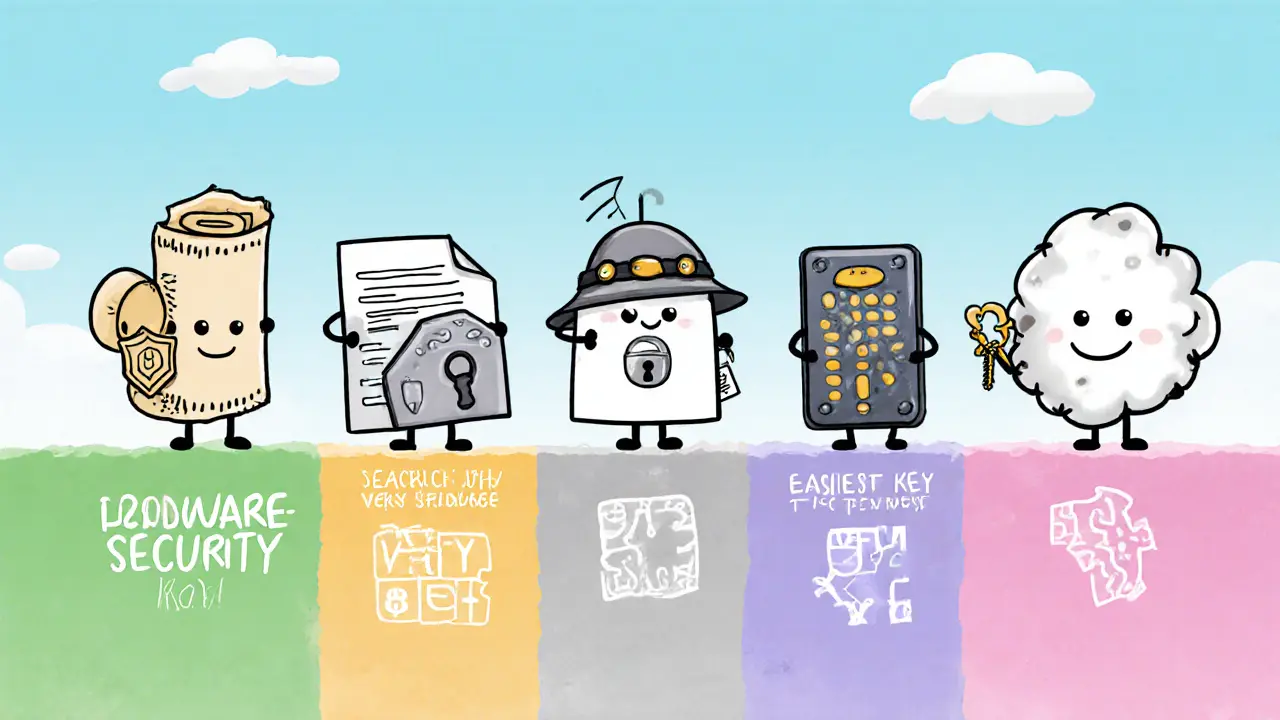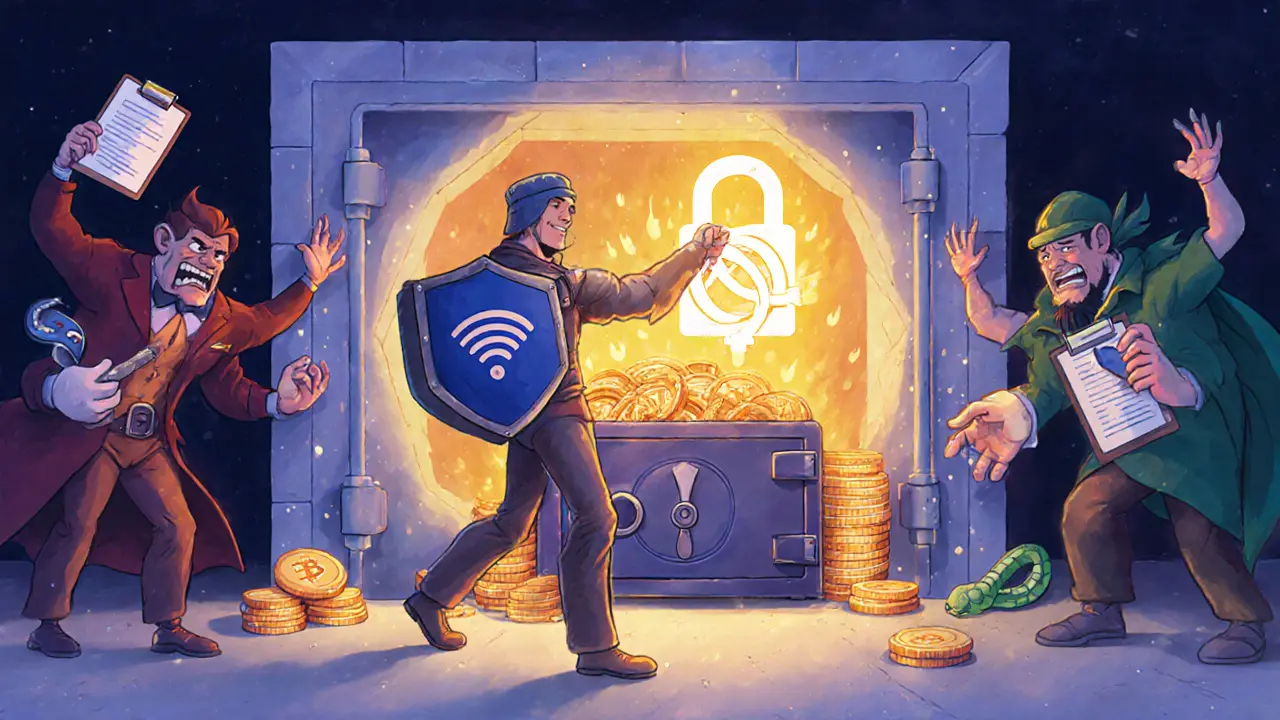Posted By Tristan Valehart On 4 Oct 2025 Comments (5)

Private Key Recovery Method Comparison Tool
Compare Recovery Methods
Select two methods to compare their characteristics side-by-side:
Comparison Results
- Security Level:
- Ease of Use:
- Cost:
- Security Level:
- Ease of Use:
- Cost:
Recovery Method Details
| Method | Security Level | Ease of Use | Typical Cost |
|---|---|---|---|
| Seed Phrase (paper) | Very high (offline) | Medium - requires manual entry | Free |
| Encrypted Backup File | High (password-protected) | Easy - click-to-restore | Free-low (software) |
| Hardware Wallet Recovery Key | Very high (secure element) | Easy - NFC or button press | Paid device ($99-$149) |
| Cloud Backup (encrypted) | Medium-High (depends on provider) | Very easy - sync automatically | Subscription ($5-$10/mo) |
| Key Splitting (Shamir Secret Sharing) | Very high (distributed trust) | Complex - requires recombination | Free-medium (software only) |
When you hear about crypto theft, the first thing that comes to mind is the private key a cryptographically generated string that gives exclusive control over digital assets on a blockchain. If that private key falls into the wrong hands, the funds vanish forever.
What Exactly Is a Private Key?
A private key is a 256‑bit number that, together with its matching public address, lets you sign transactions. The math behind it ensures that only the holder of the key can move the coins. Because the system is designed to be mathematically one‑way, anyone without the key cannot guess it, even with massive computing power.
How Do Users Usually Back Up Their Keys?
Most wallets turn the private key into a human‑readable backup called a seed phrase a list of 12 or 24 words generated by a deterministic algorithm that can recreate the original private keys. The seed phrase is the gold standard for recovery: write it down on paper, store it in a safe, or use a hardware‑backed solution.
Other backup methods include:
- Encrypted wallet files that require a password to decrypt.
- Hardware wallet recovery keys, such as the Ledger Recovery Key a PIN‑protected Secure Element chip that stores the 24‑word secret recovery phrase via NFC.
- Key‑splitting schemes where the private key is divided into multiple fragments held by different parties.
- Cloud‑based backups, which encrypt the key before uploading to a trusted provider.
Recovery Methods at a Glance
| Method | Security Level | Ease of Use | Typical Cost |
|---|---|---|---|
| Seed Phrase (paper) | Very high (offline) | Medium - requires manual entry | Free |
| Encrypted Backup File | High (password‑protected) | Easy - click‑to‑restore | Free‑low (software) |
| Hardware Wallet Recovery Key | Very high (secure element) | Easy - NFC or button press | Paid device ($99‑$149) |
| Cloud Backup (encrypted) | Medium‑High (depends on provider) | Very easy - sync automatically | Subscription ($5‑$10/mo) |
| Key Splitting (Shamir Secret Sharing) | Very high (distributed trust) | Complex - requires recombination | Free‑medium (software only) |
How Can a Private Key Be Stolen?
Even though the cryptography is solid, the human factor opens many doors for attackers. The most common attack vectors are:
- Public Wi‑Fi unsecured wireless networks that let malware sniff data packets - connecting a wallet app on a public hotspot can expose the key to a man‑in‑the‑middle.
- Clipboard Attack malware that reads the system clipboard and captures copied keys or seed words - many users copy a seed phrase to paste it into a new wallet, unwittingly handing it to a hidden process.
- Phishing sites that mimic legitimate wallet interfaces and capture the entered key.
- Malicious browser extensions that log keystrokes or read local storage files.
- Compromised hardware wallets - if the Secure Element is physically tampered with, the key can be extracted.
Chainalysis estimates that $140billion worth of Bitcoin is locked away forever because the owners lost access to their private keys or seed phrases. That number underscores how a single mistake can erase years of savings.

What About “Professional” Recovery Services?
Companies like Xpress Hacker Recovery a service that claims to recover lost or stolen crypto assets by bypassing traditional safeguards market themselves as saviors. In reality, true cryptographic security means that without the correct private key or seed phrase, no amount of brute‑force or social engineering can retrieve the funds. Most of these services operate on a “pay‑if‑you‑succeed” model, but the success rate is effectively zero unless the user already possesses some part of the credential.
Relying on such services is risky: you hand over sensitive information, pay large upfront fees, and still have no guarantee of recovery. The safest route is to use proper backups from the start.
Best Practices to Keep Your Private Key Safe
- Never share your private key or seed phrase with anyone, even trusted friends.
- Avoid using public Wi‑Fi for any wallet operation; if you must, use a trusted VPN.
- Do not copy keys to the clipboard. If you need to type them, do it manually.
- Store paper backups in fire‑proof, waterproof containers. Rotate them every few years.
- Consider a hardware wallet with a secure element and a PIN‑protected recovery key.
- Use multi‑signature or social‑recovery setups where multiple parties must collaborate to unlock the wallet.
- Encrypt any digital backup and keep the password separate from the file.
If You Think Your Wallet Was Compromised: Immediate Steps
- Confirm the breach - check transaction history for unknown transfers.
- Move any remaining funds to a brand‑new wallet with a fresh private key.
- Revoke any authorized apps or API keys linked to the compromised address.
- Change passwords on all related accounts (email, exchange, cloud storage).
- Run a full malware scan on the device used for the wallet.
- Notify the exchange or service where the stolen funds were sent, if traceable.
- Document the incident for future reference and possible legal action.
- Implement stronger security measures (hardware wallet, key splitting, etc.).
Future Directions in Private‑Key Security
Development is moving toward combining offline security with user‑friendly recovery. Examples include:
- Biometric‑linked hardware wallets that still keep the seed offline.
- Decentralized social recovery protocols that use smart contracts to authenticate a group of trusted contacts.
- Zero‑knowledge proof backups that let you verify a seed phrase without ever revealing it to a third party.
These innovations aim to reduce the “single point of failure” problem while preserving the core principle: only the rightful owner can spend the crypto.
Key Takeaways
- A private key is the sole gatekeeper to crypto assets; losing it equals losing the money.
- Seed phrases are the most reliable recovery method-keep them offline and secure.
- Public Wi‑Fi, clipboard attacks, and phishing are the top ways hackers steal keys.
- Professional recovery services cannot bypass cryptographic math; they are mostly scams.
- Adopt hardware wallets, multi‑signature, and key‑splitting to hedge against loss.

Frequently Asked Questions
Can I recover a lost private key without a seed phrase?
No. The private key is mathematically bound to the seed phrase. Without it, there is no feasible way to reconstruct the key.
Are encrypted backup files as safe as hardware wallets?
Encrypted files are safe if the password is strong and stored separately, but hardware wallets add an extra physical barrier that protects against malware.
What is a clipboard attack and how do I avoid it?
Malware watches the system clipboard and copies anything you paste, such as a seed phrase. Avoid copying keys; type them manually, or use a wallet that never places the phrase on the clipboard.
Is cloud backup a good idea for my seed phrase?
Only if the file is end‑to‑end encrypted and the encryption password is stored offline. Otherwise, a breach of the cloud provider could expose the seed.
How does social recovery work?
You assign a group of trusted friends or devices to hold partial codes. When you need to restore the wallet, a predefined threshold (e.g., 3 out of 5) must combine their parts, making it hard for a single attacker to succeed.


Alex Gatti
October 4, 2025 AT 09:23Never trust cloud backups for seed phrases.
Kimberly Kempken
October 15, 2025 AT 23:10People love to romanticize the idea of “recovering” a lost private key like it’s some mystical treasure hunt, but the truth is far uglier.
First, the mathematics behind elliptic curve cryptography is unforgiving – there is no backdoor, no secret master key lurking somewhere in the shadows.
Second, every claim that a shady service can crack a seed phrase is a scam that preys on desperation.
Third, the very notion that you can “hack” a well‑generated 256‑bit key is a fantasy nurtured by conspiracy‑minded blogs.
Fourth, the loss of a private key is analogous to throwing away a physical safe‑combination and then expecting a locksmith to conjure it from thin air.
Fifth, our obsession with backup redundancy often blinds us to the simplest mistake: writing the seed on a sticky note that later gets shredded in a fire.
Sixth, hardware wallets exist precisely to avoid the human error that leads to such loss, yet many still store the recovery phrase on a phone.
Seventh, the idea that a “recovery service” can bypass this public‑key math is a delusion bred by profit‑hungry opportunists.
Eighth, the only realistic way to regain access is to already possess a fragment of the secret – the whole premise of “full recovery” is therefore nonsensical.
Ninth, the community should stop glorifying mythic recovery tales and start preaching disciplined key hygiene.
Tenth, the best defense is a layered approach: offline paper, hardware, split‑knowledge, and no internet exposure.
Eleventh, the philosophical lesson is that ownership in crypto is absolute – you either have the key or you have nothing.
Twelfth, the moral is that no amount of clever social engineering can rewrite immutable cryptographic proofs.
Thirteenth, if you’re tempted by “miracle” services, you’re already on the losing side of the equation.
Fourteenth, accept that loss is a real risk and plan accordingly, otherwise you’ll be another statistic in the $140 billion ledger of forgotten wealth.
Fifteenth, the only way to truly “recover” is to prevent loss in the first place.
Sixteenth, stop seeking shortcuts and start building robust, redundant, and offline backups today.
John Corey Turner
October 27, 2025 AT 12:56Think of a private key as the soul of your digital vault, and the seed phrase as the whispered incantation that summons it back to life.
When you store that incantation on paper, you are giving it a physical anchor that no malware can sniff.
But the moment you copy it to a clipboard, you open a portal for silent thieves.
Every extra step you add – like encrypting a backup file – is a layer of armor against the chaos of the internet.
Remember, security isn’t a destination, it’s a journey of constant refinement.
Embrace hardware wallets, they are the modern equivalent of a steel‑bound chest with a physical key you hold.
Cathy Ruff
November 8, 2025 AT 02:43Honestly this whole “cloud backup” hype is just lazy security for lazy people, you’re basically leaving your house key on a park bench.
If you truly care about your crypto you’d keep the seed offline, not trusting some third‑party to guard it.
People keep forgetting that the moment you upload the encrypted file you’re trusting the encryption password to stay secret, and that’s a fragile promise.
Amy Harrison
November 19, 2025 AT 16:30Great reminder to keep those seed phrases safe! 👍💪 Keeping it offline is the best move.